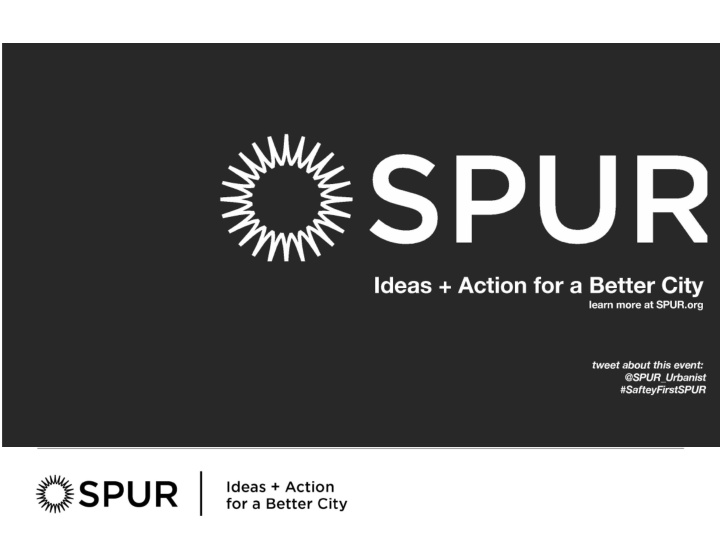



Safety First Improving Hazard Resilience in the Bay Area A white paper prepared for the SPUR Regional Strategy Laura Tam & Laurie Johnson January 2020
Key questions 1. What do we need to do to mitigate worsening hazards as the Bay Area adds people, jobs, and housing over the next 50 years? 2. As a region exposed to multiple natural hazards, what can we do together to improve community-wide resilience, that we cannot achieve acting alone as individual cities and counties?
Sea level to rise 1.4 meters in the Bay by 2100
Sea level to rise 1.4 meters in the Bay by 2100
Sea level to rise 1.4 meters in the Bay by 2100
Sea level to rise 1.4 meters in the Bay by 2100
Risks vs. Hazards The presence of natural hazards is only one part of understanding risk Risk is a function of Hazards (fires, floods, earthquakes) Exposure to a particular hazard (people, buildings, and infrastructure) Vulnerability of that exposure to damage or harm
Sea level t rise 1.4 meters in the Bay by 2100 Federally-declared disasters, last 50 years Event Jurisdictions Damage Damage Name of Disaster Category Date(s) Involved (USD) (structures) Death Toll Russian River Flood Flood May, 2019 Sonoma $155 million 1,900 1 Tubbs, Nunn, Atlas & Sonoma, Napa, Wine Country Fires Fire Oct. 2017 Solano, $18 billion 18,600 87 South Napa Earthquake Earthquake Sep. 2014 Napa, Solano $300 million 2,000 2 Contra Costa, Marin, Napa, Northern California Feb. 2006 - Solano, Flood Flood Feb. 2005 Sonoma $300 million 1000 Winter Storms and Severe Mudslides Storms Jan -Mar. 1995 Statewide $1.8 billion 10,300 28 Oakland Hills Fire Fire Oct. 1991 Alameda $1.5 billion 3,000 25 Alameda, San Mateo, Santa Clara, San Benito, Santa Loma Prieta Cruz and Earthquake Earthquake Oct. 1989 Monterey $6.9 billion 12,000 63 Santa Cruz, Northern California Contra Costa, Flood Flood Jan. 1982 Sonoma $280 million 25 - 32 Severe Storms and 40 coastal El Nino Floods 1982-83 counties $800 million 7,800 33
Sea level to rise 1.4 meters in the Bay by 2100
Sea level to rise 1.4 meters in the Bay by 2100 Pathways for hazards resilience management and governance in California ▪ Community planning: General Plans, Safety Element ▪ Disaster/emergency management: Hazard Mitigation Plans ▪ Building and lifeline codes and standards: state and local ▪ Voluntary programs: Community Wildfire Protection Plans, Firesafe Councils, NFIP ▪ Insurance: fire, flood, earthquake
Sea level to rise 1.4 meters in the Bay by 2100
Four Categories of Recommendations 1. Data and information 2. Building and lifeline codes and standards 3. Community planning 4. Funding 12 Recommendations State, Region, and Local scales
Data and information Scale Recommendation State Create dynamic multi-hazard maps that reflect property risk across multiple hazards.
Building and lifeline codes and standards Scale Recommendation State Adopt a statewide functional recovery building standard so that more buildings will be usable and easily repaired after a disaster. State, region and Require a regional inventory and local screening by building type for local vulnerabilities to wildfires, flooding, and earthquakes in areas of known risk - and require certain mandatory retrofits within 20 years. Exempt such improvements from property tax reassessment. Region Create a Regional Lifelines Council to identify interdependencies, assess vulnerability to hazards, set region-wide mitigation priorities, and identify ways to fund critical upgrades within the next ten years. Local Consolidate and expand certain special districts that serve a single purpose (fire, flood) into multi-hazard resilience districts. Local Develop local disaster recovery frameworks in every city and county to help ensure that they are ready to organizationally manage recovery following a major disaster.
Community Planning Scale Recommendation Local Rezone high-hazard areas to prevent further expansion of development, particularly into the Wildland-Urban Interface, or in areas significantly vulnerable to liquefaction and sea level rise - with priority consideration in those areas where multiple hazards overlap. Ensure no net loss of planned housing by upzoning or transferring development rights to existing urbanized areas instead. Local Acquire undeveloped hazard-prone lands for public ownership and use.
Funding Scale Recommendation State or region Develop a regional or state buyout program for repeat-disaster properties affected by wildfire, flooding, or other hazard impacts. State Ensure that insurance for fire, earthquake and flood hazards remains available and affordable for residents and businesses. Ensure that state policy encourages and appropriately prices smarter land use, new construction, and retrofit practices. Region Establish a region-wide or series of county-wide Geological Hazard Abatement Districts to pool resources to fund regional resilience projects. Region Establish a Regional Resilience Trust Fund for future climate adaptation and hazard management needs.
Thank you
Recommend
More recommend